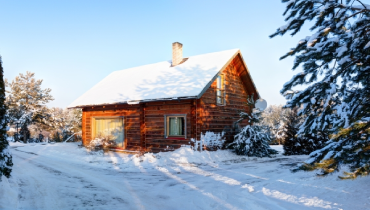
A vacant house is prime real estate for a frozen and ruptured pipe and the resulting flooding that goes with it. Instead of taking a chance with this catastrophe, prepare your plumbing for winter weather before it’s too late. The professionals at Mr. Rooter® Plumbing have compiled simple steps to explain how to winterize pipes in your vacant house.
Why Should I Winterize Pipes?
If you have a house or cottage that is going to be vacant during cold weather, there are some things you should do to ensure you don’t walk into a mess when you open it up again (a busted water pipe). It’s doubly important when people aren’t around to keep an eye on the temperature where your property is located. Knowing how to winterize cottage plumbing will keep your plumbing system intact and the cottage safe even during the coldest months by preventing burst pipes, flooding, and property damage.
Related Topic: Why You Shouldn’t Thaw Frozen ABS Pipes Yourself
The Best Way to Winterize Water Pipes
Prepping a vacant house for freezing weather is about more than just putting garden hoses away for the winter. Here’s the best way to winterize water pipes and supply lines for winter:
- Turn off the main water valve to the house. There will be a wheel valve or handle you can turn clockwise to shut off the water supply.
- Flush the toilets after turning off the main water valve to drain the toilet tanks.
- Turn on all the water taps throughout the house to drain them and prevent any residual water from freezing. Although there will still be some water in the lines, this will significantly reduce the pressure throughout your plumbing system.
- Turn off and drain the water heater tank to protect the inside of the tank and the heating elements.
- Insulate pipes for added protection against the winter cold.
- Never turn off the heat. Keeping the heat at about 12°C or more will help prevent pipes from freezing.
Winterizing Toilets and Drains
Getting the toilets and drains prepped for winter is easier than it sounds. In addition to flushing the toilet after the main water supply is off, follow these steps:
- Remove any remaining water from the tank and the bowl by soaking it up with rags or sucking it up with a wet/dry shop vac.
- Detach the water supply hose from the side of the toilet and let the water drain out. Have a bucket or towel ready to catch water drips.
- Pour non-toxic antifreeze into the toilet tank and then flush the toilet to distribute it to the overflow lines.
To winterize your drains, follow these steps:
-
Pour non-toxic plumbing antifreeze (commonly known as RV antifreeze) into all drains in the sinks, tubs, and showers in the house.
- If your home or cottage is going to be vacant for an extended period, put a small amount of cooking oil in sink drains to keep the P-traps from drying out and to stop any sewer gases from seeping up into the house.
Winterizing a house with well water requires one or two more steps. First, go to your circuit breaker panel and turn off the breaker that sends power to the well pump. Then, if you have a shallow well with a jet pump, follow the manufacturer’s instructions to drain water from the unit. Or contact your local plumber to do it for you.
Need Help with Frozen Pipes
Even with the best planning and preparation, things can still go wrong in a vacant house. If this happens and you return to find frozen or burst pipes, contact your local Mr. Rooter Plumbing for repairs you can count on. Call us or request a job estimate online.
If it’s too late and your cottage has sustained water damage due to a burst pipe, our colleagues at Rainbow International can help. They set the industry standard for water damage restoration services. And because they’re part of the Neighbourly network, you can trust them to deliver outstanding customer service.